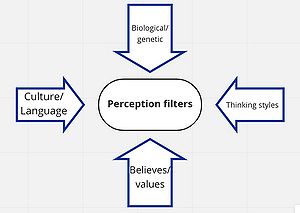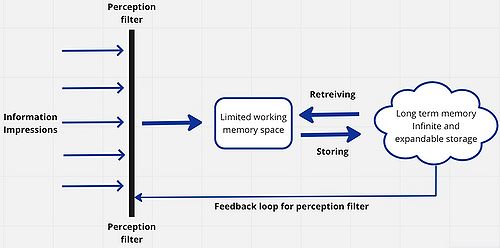Perception filters in project management
(→How perception filter influences the success of project management (Belling 2004)) |
|||
| Line 8: | Line 8: | ||
=== How perception filter influences the success of project management (Belling 2004) === | === How perception filter influences the success of project management (Belling 2004) === | ||
| − | The perception filter works in a way that only small parts of all of the information that the brain is exposed to, is filtered through and reflected upon, this depends on the receptors’ earlier references. The message that is communicated to the receptor will be compared to similar, already experienced situations, and when one is found it will operate as the framework for the current situation. This filter will form the experience of the information and how it is interpreted, for example if the receptor interprets a message as a compliment or an insult, based on how they relate to the matter. Furthermore the filters can work as blockings, if during a meeting, a lot of information is being communicated the listeners filters can lead to that only parts of the message is being received. What is relevant for one coworker, and therefore filtered through, will be remembered, but this can easily be completely different for the other colleague. What can be different is with what kind of perspective one works from, if it is personal or purely business, this will affect ones' selection of captured information. The desired team member for a project manager is therefore an individual that holds an even combination of both emotional and business knowledge to avoid information being blocked away and receive a proportional part of the message. <ref> | + | The perception filter works in a way that only small parts of all of the information that the brain is exposed to, is filtered through and reflected upon, this depends on the receptors’ earlier references. The message that is communicated to the receptor will be compared to similar, already experienced situations, and when one is found it will operate as the framework for the current situation. This filter will form the experience of the information and how it is interpreted, for example if the receptor interprets a message as a compliment or an insult, based on how they relate to the matter. Furthermore the filters can work as blockings, if during a meeting, a lot of information is being communicated the listeners filters can lead to that only parts of the message is being received. What is relevant for one coworker, and therefore filtered through, will be remembered, but this can easily be completely different for the other colleague. What can be different is with what kind of perspective one works from, if it is personal or purely business, this will affect ones' selection of captured information. The desired team member for a project manager is therefore an individual that holds an even combination of both emotional and business knowledge to avoid information being blocked away and receive a proportional part of the message. <ref> (Belling 2004) </ref> |
== The influence of perception filters == | == The influence of perception filters == | ||
Revision as of 18:16, 1 March 2023
Contents |
Concept
What are perception filters?
Perception filter is the processing of new information in our brain, how it will be interpreted is individual and is affected by prior knowledge, cultural aspects, personality, former experiences and much more. Perception is the way the receiver intercepts information, decodes it, and acts thereafter. Communication is important in all fields of work and in everyday life, it is something granted for most but can be interpreted and received differently from person to person. Language, words and expressions reach individuals on different levels due to different processes in the brain. This human phenomena is called a perception filter. There are two aspects to consider, perception and understanding, how one perceives information and action, how one converts information into action. Research led to the conclusion that neurological framework and environmental experiences might be the reason to this. The perception filter functions in our consciousness, it is not physically a part of the brain, and also affects our learning. If an individual scans through a random series of book titles most of them will go unnoticed and be forgotten within a short period of time. This is due to the lack of connection to prior knowledge in the mind, and when something catches one's interest it is often because it connects with something that already is stored in the long term memory. This is developed by the perception filter, and the information can be added to the long term storage. The amount of information that each person is exposed to each day is enormous, the perception filter is an aid to filter out some of it, because the brain can not absorb all the information that is given to it. Studies have also shown that genetics can play a large role in perception of emotions, different genetic profiles affected differently by social interactions. As a project manager it is of great importance to take the aspect of perception filters in coworkers into account. This is due to the considerable amount of communication this line of work demands, communication with coworkers, stakeholders and team members. These different roles will come from different views of the project, with various backgrounds and standpoints to the projects, and it is crucial that the project manager manages to keep them satisfied in order to proceed with the work.
How perception filter influences the success of project management (Belling 2004)
The perception filter works in a way that only small parts of all of the information that the brain is exposed to, is filtered through and reflected upon, this depends on the receptors’ earlier references. The message that is communicated to the receptor will be compared to similar, already experienced situations, and when one is found it will operate as the framework for the current situation. This filter will form the experience of the information and how it is interpreted, for example if the receptor interprets a message as a compliment or an insult, based on how they relate to the matter. Furthermore the filters can work as blockings, if during a meeting, a lot of information is being communicated the listeners filters can lead to that only parts of the message is being received. What is relevant for one coworker, and therefore filtered through, will be remembered, but this can easily be completely different for the other colleague. What can be different is with what kind of perspective one works from, if it is personal or purely business, this will affect ones' selection of captured information. The desired team member for a project manager is therefore an individual that holds an even combination of both emotional and business knowledge to avoid information being blocked away and receive a proportional part of the message. [1]
The influence of perception filters
The impacts on learning (White 2012)
The brain is a complicated part of our body, it is thinking and choosing not to think about millions of visions each day. For example, walking down a street, one is meeting hundreds of faces in the time span of a couple of minutes, but still, during these minutes you will only have noticed and remembered a few of these faces or just the one you were looking for to meet. Another situation, hundreds and hundreds of noises go unnoticed each day, but the whistle from a train at night outside your new apartment waking you, will disturb you. Some time later this noise won’t bother you, the mind learns to adjust and the sound goes unnoticed thanks to the perception filter. This is one part of the perception filter, but it operates in all parts of our consciousness, and also for our learning. When teaching, the perception filters in the students affect how much of the given information that is absorbed and taken in, and this should be taken in account for.
There are models explaining this phenomena, for example the Bloom’s taxonomy that describes the cognitive ability in the form of a hierarchy, the Perry model that provides college students’ ethical and intellectual development, or sectioning of different personality types in order to understand peoples’ interactions. This is something foreign to traditional textual educational models.
The perception filter is not a physical part of the brain, it is an idea. When scanning through book titles and summaries, the eyes scan through many of them and stop at some of them to read further. This depends on whether something in the title or outlook was caught in our perception filter, see figure xi. The one that caught our eye will have a link or connection to something our memory already has knowledge about. The book went through the perception filter and can now be processed and added to the long term memory, this is important, if one doesn’t have the capacity to read all the titles on the shelf. However, during an education, some subjects and information will have difficulty slipping through the perception filter, and this is something teachers need to account for. It can be difficult to acquire the information from the speaker in the long term memory if it is not presented in the right way, the speaker needs to adjust the tone, choice of words et cetera after its’ audience. Cite error: Closing </ref> missing for <ref> tag
Cite error:
<ref> tags exist, but no <references/> tag was found

